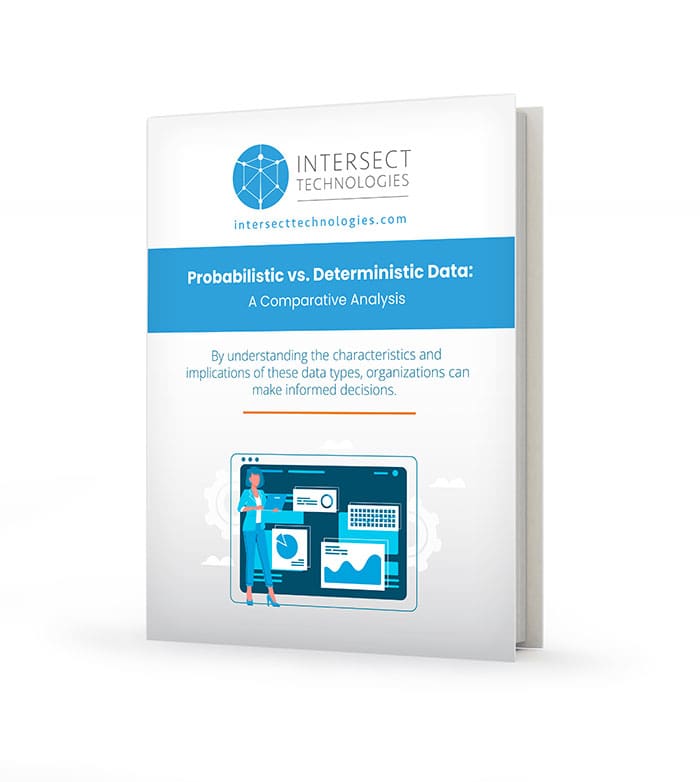Data plays a pivotal role in decision- making, problem-solving, and gaining insights in every field under the sun. When it comes to probabilistic vs. deterministic data, what’s the difference?
The two fundamental approaches to representing and analyzing data are probabilistic and deterministic. By understanding the characteristics and implications of these data types, organizations can make informed decisions regarding data modeling, analysis, and prediction.
Distinct Perspectives on Data Analysis
The availability of vast amounts of data has led to the development of diverse methodologies for understanding and utilizing all the information at our fingertips, thanks to the internet. Probabilistic and deterministic data are two prominent paradigms that offer distinct perspectives on data analysis and decision-making, even with their distinct differences.
Section One: Probabilistic Data
Probabilistic data refers to information that incorporates uncertainty and randomness into its representation. It recognizes that many real-world phenomena are inherently uncertain and cannot be precisely determined. Probabilistic data is typically represented using probability distributions, which capture the likelihood of different outcomes, accounting for the Butterfly Effect – the randomness of reality.
Applications of Probabilistic Data
- Risk assessment and management: Probabilistic data allows for quantifying and evaluating uncertainties in business niches like finance, insurance, and engineering.
- Decision-making under uncertainty: Probabilistic data figures in the unpredictable as variables, optimizing choices based on expected outcomes and associated probabilities.
Advantages of Probabilistic Data
- Ability to model and reason about uncertainty: Probabilistic data provides a flexible framework for representing and reasoning about uncertain events, enabling more realistic and robust analysis accounting for randomness.
Challenges of Probabilistic Data
- Incorporation of prior knowledge: Probabilistic models allow the integration of prior information, combining data-driven insights with existing knowledge or domain expertise.
Section Two: Deterministic Data
Deterministic data represents information without incorporating uncertainty. It assumes that events can be accurately predicted and described by precise values or rules, like solving a math equation. Deterministic models provide a fixed relationship between inputs and outputs, making them suitable for scenarios with little or no inherent randomness.
Applications of Deterministic Data
- Physics and engineering: Deterministic models are commonly used to simulate physical systems, engineering processes and predict outcomes with high precision. What you put in is what you get out, and randomness doesn’t play a huge factor. Deterministic algorithms are employed in various optimization problems, such as supply chain management, resource allocation, and scheduling.
- Rule-based systems: Deterministic data plays a crucial role in rule-based systems, where decisions are made based on predefined conditions and logical rules – think computer programming.
Advantages:
- Precision and determinism: Deterministic data provides a clear cause-and-effect relationship, allowing for precise predictions and reproducibility.
- Efficiency: Deterministic algorithms are often computationally efficient, enabling rapid processing and real-time decision-making in time-sensitive applications.
- Interpretability: Deterministic models offer transparent explanations of their behavior, facilitating understanding and trust in the decision-making process.
Challenges:
- Inability to capture uncertainty: Deterministic data lacks the ability to account for inherent uncertainties in real- world scenarios, potentially leading to overly confident predictions not taking out a randomness factor.
- Sensitivity to initial conditions: In systems governed by chaos theory, small variations in initial conditions can lead to significant differences in outcomes, challenging the accuracy of deterministic predictions.
- Limited adaptability: Deterministic models may struggle to handle dynamic and evolving environments, as they do not readily accommodate changing conditions or unforeseen events.
Probabilistic vs. Deterministic Data: A Comparative Analysis
Probabilistic and deterministic data offer different perspectives on data analysis and decision-making. While probabilistic data embraces uncertainty and models it explicitly, accounting for the randomness of everyday life, deterministic data assumes precise knowledge and deterministic relationships that won’t change with random variables. For example, the weather could never be deterministic, as wind patterns, rain, sunshine, and other factors are always random. The choice between these approaches depends on the nature of the problem, available data, and the desired level of certainty.
Choosing the Right Approach
- Problem characteristics: Assess the presence and impact of uncertainties in the problem you’re looking to solve for. If there’s an element of randomness, probabilistic data may be more appropriate.
- Data availability: Consider the amount and quality of available data. Probabilistic models often require larger datasets.
- Interpretability requirements: Determine the need for transparent and explainable predictions. Deterministic models often offer more intuitive explanations compared to probabilistic models.
Conclusion: Probabilistic vs. Deterministic Data. You Know the Difference!
In conclusion, the choice between probabilistic and deterministic data approaches depends on various factors such as the nature of the problem, data availability, and interpretability requirements.
Probabilistic data embraces uncertainty and randomness, offering a flexible framework for modeling and reasoning about uncertain events. It allows for quantifying and evaluating risks, making it suitable for decision-making under uncertainty. However, probabilistic models may require a substantial amount of data and can be challenging to interpret due to the randomness factor.
On the other hand, deterministic data represents information without incorporating uncertainty, providing a clear cause-and- effect relationship. Deterministic models excel in scenarios where precision and reproducibility are crucial, such as physics, engineering, and rule-based systems. They offer efficient processing and transparent explanations, enabling real-time decision- making and fostering understanding and trust. However, deterministic models struggle to capture inherent uncertainties, are sensitive to initial conditions, and may have limited adaptability in dynamic environments.
Choosing the right approach involves assessing the problem characteristics, considering data availability, and evaluating interpretability requirements. If uncertainties play a significant role and transparency is essential, probabilistic data may be more appropriate. On the other hand, if precise predictions and efficiency are crucial, deterministic data can be a suitable choice.
In today’s data-driven world, understanding the characteristics and implications of probabilistic and deterministic data is crucial for organizations to make informed decisions regarding data modeling, analysis, and prediction. Both approaches have their strengths and limitations, and choosing the appropriate one for a given problem
can lead to more accurate and insightful results. By considering the comparative analysis presented in this article, organizations can leverage the power of data to enhance their decision-making processes and gain a competitive edge in their respective fields.





